The history of the flag of the territories that make up the modern Democratic Republic of the Congo is closely linked to the colonial period, which begins with the founding of the Association Internationale Africaine. Founded after the Brussels Conference of 1876, the AIA was established as an international philanthropic organization under the leadership of King Leopold II. Its official goal was to develop cultural life in Africa, fight the slave trade, and raise funds for these purposes. In practice, however, its activities quickly became a cover for Belgian colonial expansion, particularly through the Committee for the Study of the Upper Congo, established in 1878. The IAA flag was simple: a blue cloth with a yellow five-pointed star in the center. The star symbolized the “light of civilization” that the association was supposed to bring to the dark African continent. Between 1877 and 1885, during his expeditions, Leopold II signed treaties with local African leaders that laid the groundwork for the creation of the Independent State of the Congo (État Indépendant du Congo ) in 1885 and gave Leopold II personal control over large areas of Central Africa. These territories became his de facto private property, where the local population was subjected to incredibly harsh working conditions, and refusal to comply with production standards was punished by torture, which at best led to mutilation, and at worst escalated into mass murder. For this purpose, there were special armed units called “Force Publique” that carried out terror and violence, including the amputation of hands of those who did not comply with the norms. These atrocities came to light thanks to journalists and their investigations, which revealed the extent of the violence and caused a global outcry. The human rights campaign in the United Kingdom and the United States forced the Belgian government to intervene in 1908 and take control of the territory, creating the Belgian Congo (Congo Belge). During these three periods (1877-1960): International African Association, Independent State of Congo, and Belgian Congo, the same blue flag with a yellow star in the center, created from the beginning for the IAA, was used.
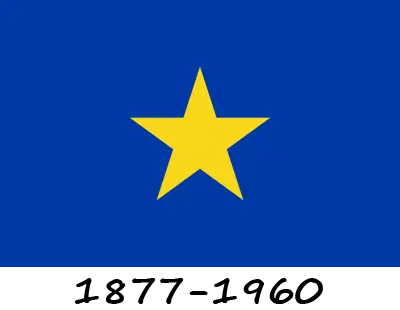
The Belgian colonial government was not perfect either, and over the years, discontent accumulated in society, which began to turn into protests. Therefore, in 1959, after another massive protest in Leopoldville, Belgium announced that Congo would become an independent state in 1960. The first elections were held in May 1960, as a result of which Patrice Lumumba was elected Prime Minister and Joseph Kasavubu was elected the first President. On June 30, 1960, the former Belgian colony of Congo became the Republic of Congo-Leopoldville. The name “Leopoldville” comes from the name of the Belgian King Leopold II, as the city, which was founded as a trading post in 1881, was named in his honor and later became the capital of the colony. This name was used until 1966, when the city was renamed Kinshasa. This was a step towards eradicating the colonial legacy and restoring African customs and cultural values. For centuries, the area was inhabited by the Bantu (Teke, Humbu [French]) and known as Nshasa. Therefore, the name change is a tribute to the village of Nshasa. The flag of the Republic of the Congo-Leopoldville consisted of a blue cloth with six yellow five-pointed stars arranged vertically along the left edge and a seventh large star in the center of the flag. The six stars symbolized the six main provinces of the Republic of Congo at the time of its independence.
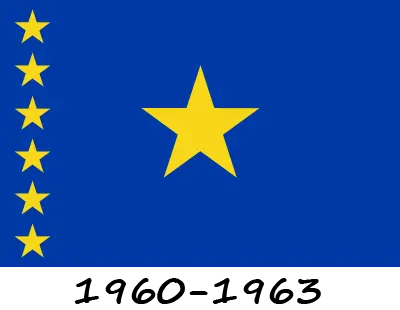
However, shortly after independence, the country plunged into chaos. The Congolese army soldiers were dissatisfied with the Belgian command and revolted, and Belgium decided to intervene by sending in troops without government permission. This caused a protest, and the Congo turned to the UN for help, resulting in the creation of the ONUC (Organization des Nations Unies au Congo) peacekeeping mission. The purpose of the organization, which at that time became one of the largest UN operations, was to help liberate the territory from foreign troops and stabilize the situation in the country. The mission ended in June 1964, despite the fact that final peace and stability were not achieved.
In 1965, Joseph Mobutu, a colonel in the Congolese army, staged a second coup d'état, removing the first president of the Congo, Joseph Kasavuba. Mobutu promised to restore stability and national unity, but in 1967, having created the Mouvement Populaire de la Révolution (People's Movement of the Revolution) party, he declared himself the sole leader and began a repressive policy.
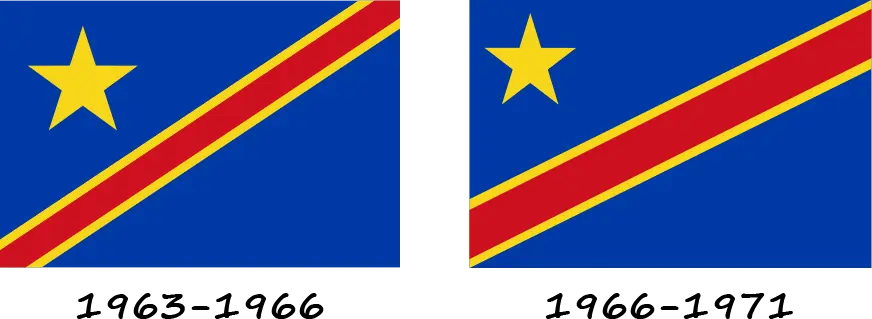
Between 1963 and 1971, a new flag was adopted, also blue with only one yellow star in the upper left corner and a diagonal red stripe with a yellow outline, although in 1966 this stripe did not change its design significantly.
In 1971, Mobutu renamed the country Zaire as part of his “authenticity” campaign, which aimed to eradicate anything that might be associated with the colonial past. Despite its African roots (Congo is the name of the local population and river), Mobutu believed that the name was linked to the time of Leopold II and the Belgian administration, when the country was known as the Belgian Congo. Instead, the name “Zaire” comes from the Portuguese interpretation of the local name for the Congo River, Nzere or Nzadi (meaning “great river” in Bantu). During their travels in the 15th century, Portuguese explorers distorted the name to “Zaire”.
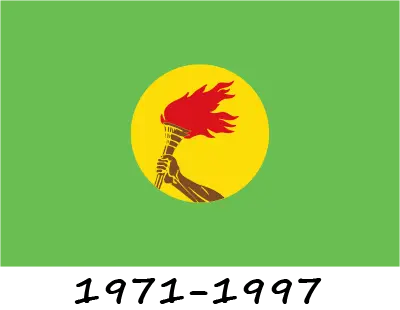
The flag of the Republic of Zaire, used from 1971 to 1977, had a unique design that differed significantly from the previous and subsequent flags of the Democratic Republic of the Congo. This flag was solid green with a central yellow disk depicting a hand holding a torch with a red flame. The green color symbolized the wealth of natural resources and fertility of the land, the yellow color pointed to the sun as a source of light and hope, and the hand with the torch illuminated and showed the way to an independent and bright future.
During the First Congolese War (1996-1997), the dictatorial regime of Mobutu Sese Seko, who had ruled the country for almost 32 years, was overthrown. The rebels, led by Laurent-Désiré Kabila and supported by neighboring countries (Rwanda and Uganda), captured the country's capital, Kinshasa, in May 1997. After that, Zaire was renamed the Democratic Republic of the Congo again, and a new-old flag was adopted. That is, the flag that was in use during the Republic of the Congo-Leopoldville (1960-1963) was returned to use - a blue flag with a central large star and six smaller ones arranged vertically on the left side. Only the shade of the blue background was changed to a lighter one.
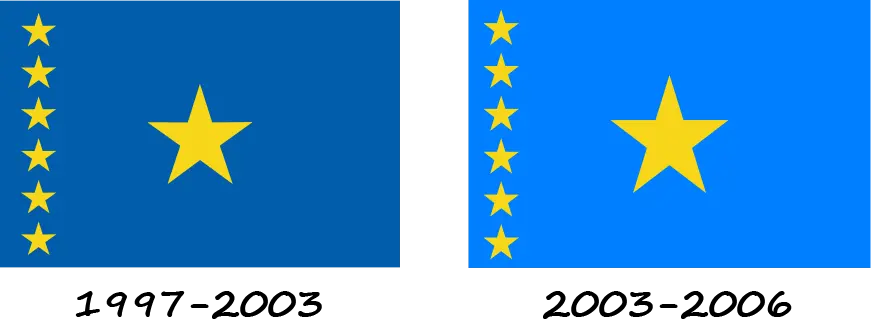
The first Congolese war was quickly followed by the Second (1998-2003), also known as the “African World War”. This war involved nine African states in the conflict and led to massive losses among the population - about 5 million people died. Laurent-Désiré Kabila, who led the country in 1997, was assassinated in 2001 and his son Joseph Kabila took his place. After the end of major hostilities in 2003, a transitional government was established, but the country still suffered from internal armed conflicts and political crises.
Finally, in 2006, the Democratic Republic of the Congo adopted its current flag, which looks like the past flag used from 1963 to 1971, except that the blue background is lighter and the diagonal red stripe is wider. That same year, the Congo held its first democratic elections since 1960, officially ending the period of the transitional government established in 2003 and ushering in an era of recovery for the Congo after years of decline.










